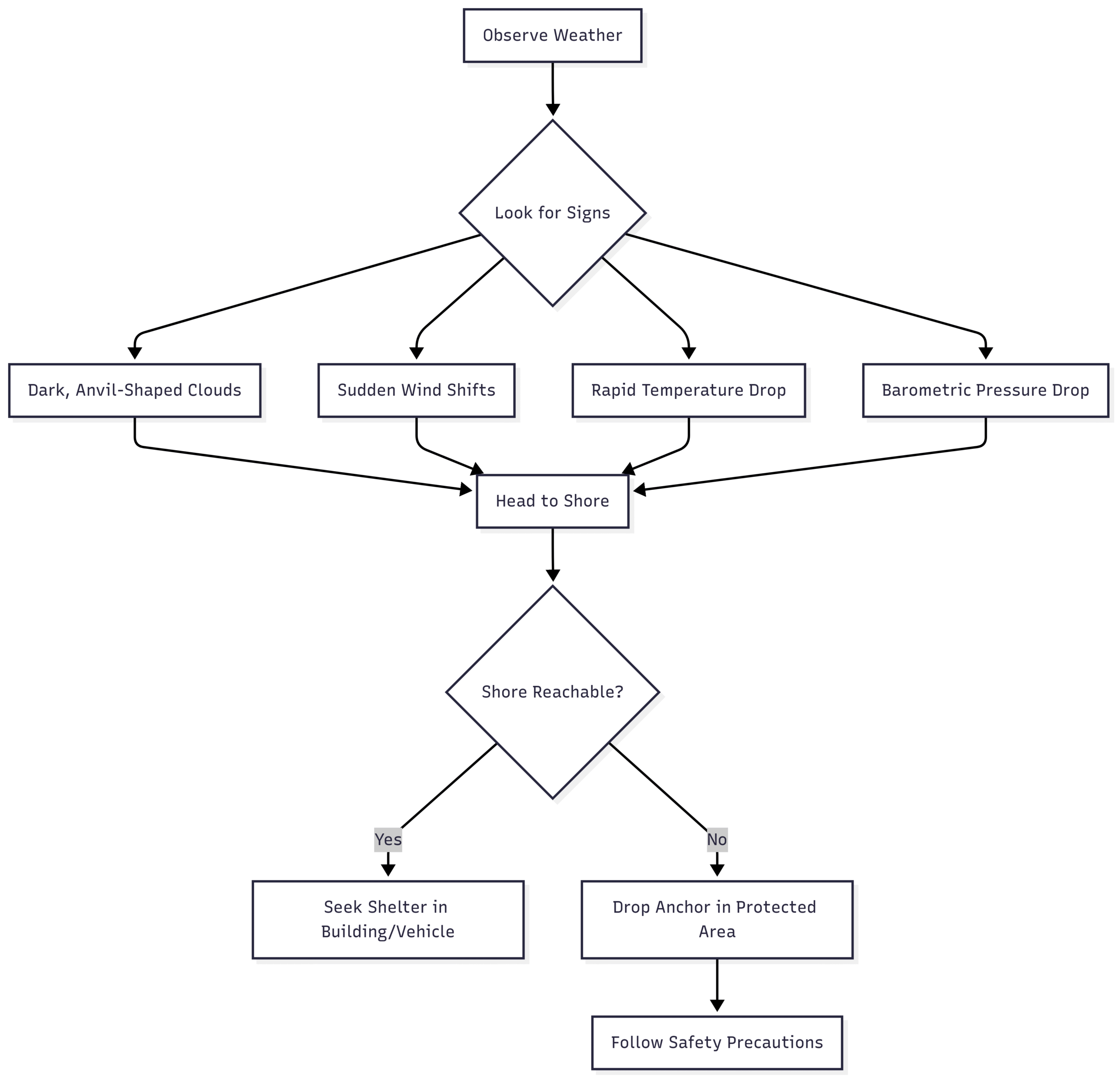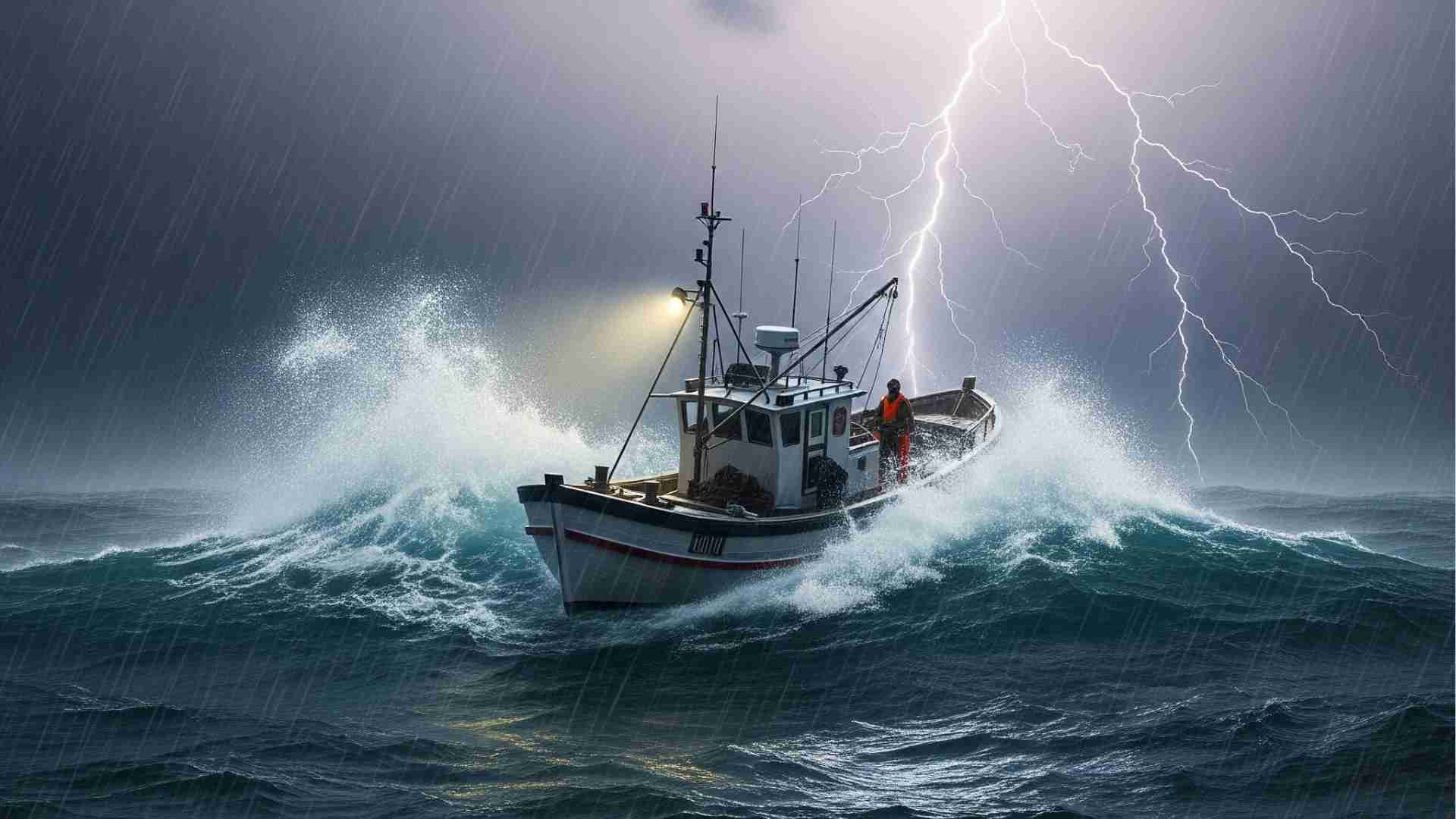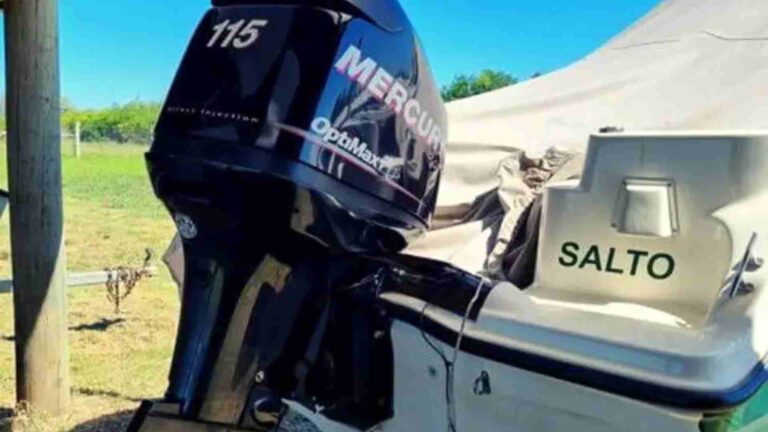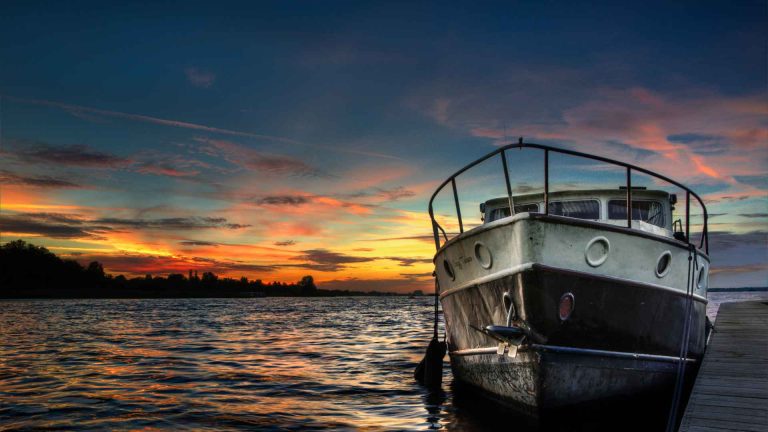Boating in a Thunderstorm: How to Stay Safe in a Storm
Learn how to stay safe while boating in a thunderstorm with expert tips on seeking shelter, wearing life jackets, and avoiding lightning risks.
Thunderstorms can transform a pleasant day on the water into a dangerous situation in minutes. With lightning, heavy rain, strong winds, and unpredictable waves, boaters face significant risks if caught unprepared. Lightning alone strikes approximately one in 1,000 boats annually, with Florida and the Chesapeake Bay accounting for over 60% of claims, according to BoatU.S. data. The combination of water and electricity creates a hazardous environment, potentially leading to electrocution, fires, or damaged electronics. This comprehensive guide provides actionable strategies to stay safe, prepare effectively, and minimize risks when boating during a thunderstorm.
Understanding the Dangers of Thunderstorms on the Water
Thunderstorms pose unique challenges for boaters due to their rapid onset and severe conditions. Unlike on land, where shelter is often nearby, boaters may find themselves exposed on open water with limited options. The primary dangers include:
- Lightning Strikes: Lightning seeks the highest point, often the boat’s mast, antenna, or even a person. A direct strike can cause fires, disable electronics, or result in serious injury or death.
- Reduced Visibility: Heavy rain and fog can obscure navigation, increasing the risk of collisions or running aground.
- Strong Winds and Waves: Gusty winds create choppy waters, making it difficult to maintain control of the vessel.
- Waterspouts: These tornado-like phenomena can capsize boats or cause significant damage.
Given these risks, preparation and vigilance are critical. Boaters must understand weather patterns, recognize warning signs, and have a clear safety plan to mitigate dangers.
Pre-Trip Preparation: The Foundation of Thunderstorm Safety
The best defense against thunderstorms is avoiding them altogether. By checking weather forecasts and preparing your vessel, you can significantly reduce the likelihood of being caught in a storm.
Check the Weather Before You Go
Always review weather forecasts before heading out. Marine-specific weather apps and services provide detailed information, including radar imagery, barometric pressure, and wave height predictions. Apps like Windy, PredictWind, or NOAA Weather Radar offer real-time updates tailored for mariners. For radio updates, tune into NOAA Weather Radio on VHF channels 1-9, with Channel 3 being the most common for marine forecasts.
Key indicators to watch for in forecasts include:
- Probability of thunderstorms
- Expected wind speeds and wave heights
- Barometric pressure drops, which signal approaching storms
If a forecast indicates a high chance of thunderstorms, postpone your trip. Even a 30% chance of storms warrants caution, as conditions can escalate quickly.
Assemble a Thunderstorm Safety Kit
A well-prepared safety kit can make a significant difference during a storm. Keep the following items on board:
| Item | Purpose |
|---|---|
| Life Jackets | Ensure all passengers have properly fitted life jackets. |
| First Aid Kit | Treat minor injuries or stabilize conditions until help arrives. |
| VHF Radio (Handheld) | Communicate in emergencies if primary systems fail. |
| Fire Extinguisher | Combat fires caused by lightning strikes. |
| Visual/Sound Signaling Devices | Signal for help in low-visibility conditions (flares, whistle, air horn). |
| Anchor with Line | Secure the boat if stopping is necessary. |
| Oars or Paddles | Manual propulsion if the engine fails. |
| Flashlight | Illuminate the boat during low-visibility conditions. |
Store electronics like handheld VHFs or GPS units in a microwave or tinfoil-lined container to act as a makeshift Faraday cage, protecting them from lightning-induced electromagnetic pulses.
Develop a Thunderstorm Safety Plan
Create a written safety plan and ensure all passengers are familiar with it. Include:
- Escape Routes: Identify nearby safe harbors or landings.
- Roles and Responsibilities: Assign tasks, such as securing gear or monitoring the radio.
- Emergency Procedures: Outline steps for handling injuries, fires, or equipment failure.
Print the plan and store it in a waterproof container, such as in the glove compartment, for quick reference. Involve all passengers, including children, in learning the plan to ensure everyone knows how to act in an emergency.
Recognizing Thunderstorm Warning Signs
Even with a solid forecast, weather can change rapidly. Boaters must develop a “watchful weather eye” to spot early signs of a thunderstorm. Common indicators include:
- Cloud Formations: Large, puffy cumulus clouds that darken and form an “anvil” shape at the top signal a potential thunderstorm. The anvil often points in the direction the storm is moving.
- Wind Shifts: Sudden changes in wind direction or speed can indicate an approaching front.
- Temperature Drops: A rapid cooling of the air often precedes a storm.
- Barometric Pressure: A sudden drop in pressure, detectable with a barometer, suggests worsening weather.
If you observe these signs, head to shore immediately or stay near a safe landing until conditions stabilize. Use the 30/30 Rule: if you see lightning and hear thunder within 30 seconds, the storm is within 6 miles, and you should seek shelter immediately.
Chart: Thunderstorm Warning Signs and Actions

This chart outlines the decision-making process when thunderstorm signs appear, guiding boaters to safety.
What to Do If Caught in a Thunderstorm
Despite your best efforts, you may find yourself on the water during a thunderstorm. Follow these steps to stay safe:
Seek Shelter Immediately
- Head to Shore: If possible, return to a dock and seek shelter in a sturdy building or vehicle. Avoid open areas or trees, as they attract lightning.
- Use a Cabin: If your boat has an enclosed cabin, move inside and avoid touching metal surfaces or electrical devices. Cabins provide partial protection, especially on boats with metal hulls, which can act as Faraday cages.
- Drop Anchor: If shore is unreachable, find a protected area, such as a cove, and drop anchor to stabilize the boat.
Safety Precautions During the Storm
- Wear Life Jackets: Ensure all passengers wear properly fitted life jackets. In rough waters or if the boat capsizes, life jackets are critical for survival.
- Lower Metallic Objects: Secure or lower antennas, fishing rods, outriggers, or other metal objects that could attract lightning. If part of a lightning-protection system, leave them in place.
- Stay Low: Position yourself and passengers near the center of the boat, ideally on the floor, to minimize height and reduce lightning strike risk.
- Avoid Metal and Electronics: Refrain from touching metal railings, steering wheels, or electrical equipment, as these can conduct electricity. If steering is necessary, use a wooden spoon or wear rubber gloves for insulation.
- Secure Gear: Tie down loose items to prevent them from becoming hazards in high winds or rough seas.
- Reduce Speed: Navigate at the minimum speed needed to maintain control, hitting waves at a 45-degree angle to reduce impact.
- Monitor Weather: Use radar or NOAA Weather Radio to track the storm’s progress and anticipate its duration.
Wait Out the Storm
Thunderstorms are typically brief, lasting 20-30 minutes. Wait at least 30 minutes after the last thunderclap before resuming activities like fishing or swimming. This ensures the storm has moved beyond striking distance.
Lightning Protection Systems for Boats
Some boats, particularly larger vessels like trawlers or sailboats, come equipped with lightning-protection systems. These systems include:
- Air Terminal (Lightning Rod): A metal rod at the highest point of the boat.
- Grounding System: A thick wire connecting the air terminal to a metal ground plate submerged in the water.
- Bonding: Connecting large metal objects (e.g., engines, tanks) to the grounding system to create a low-resistance path for lightning current.
For open boats, portable lightning-protection systems are available, consisting of a pole, wire, and ground plate. While not foolproof, these systems can reduce damage to electronics and lower the risk of injury.
Table: Lightning-Protection System Components and Costs
| Component | Description | Estimated Cost |
|---|---|---|
| Air Terminal | Metal rod to attract lightning safely. | $50-$200 |
| Grounding Wire | Heavy-gauge wire to conduct lightning to the ground plate. | $20-$100 |
| Ground Plate | Submerged metal plate (min. 1 sq. ft.) to dissipate lightning current. | $50-$150 |
| Bonding Cables | Connects metal objects to the grounding system. | $30-$100 |
| Portable Protection Kit | Pole, wire, and ground plate for open boats. | $150-$400 |
| Professional Installation | Ensures proper setup and compliance with safety standards. | $500-$2,000 |
Note: Costs vary based on boat size and system complexity. Consult a marine electrician for installation.
What to Do After a Lightning Strike
If your boat is struck by lightning, act quickly to assess and address the situation:
- Check for Injuries: Immediately check passengers for signs of injury. If someone is unconscious or not breathing, begin CPR. Victims of lightning strikes are safe to touch and do not carry residual charge.
- Inspect for Damage: Check the bilge for water, as lightning can damage through-hulls or create holes. Use bilge pumps, bail buckets, or plugs to manage leaks.
- Signal for Help: If the situation is dire, use a VHF radio to call for assistance or deploy flares if the radio is damaged.
- Protect Electronics: Store backup electronics in a microwave or tinfoil-lined container to shield them from electromagnetic pulses.
- Assess Systems: After the storm, test the engine, navigation, and communication systems. Even a near strike can damage electronics or engine control units.
After the incident, have a professional marine surveyor inspect the boat for hidden damage, such as micro-cracks or electrical issues, which may not be immediately apparent. Report all damage to your insurance provider, as lightning strikes are typically covered under comprehensive boat insurance policies.
Regional Considerations: Where Lightning Strikes Most
Lightning strike frequency varies by region, with some areas posing higher risks. According to BoatU.S., Florida accounts for 33% of lightning-related insurance claims, while the Chesapeake Bay accounts for 29%. Other high-risk areas include coastal regions of Louisiana, Texas, and the Carolinas, where thunderstorm activity peaks during summer months.
Table: Top Regions for Lightning Strikes on Boats
| Region | Percentage of Claims | Average Thunderstorm Days/Year |
|---|---|---|
| Florida | 33% | 70-100 |
| Chesapeake Bay | 29% | 30-50 |
| Gulf Coast (LA, TX) | 15% | 50-70 |
| Carolinas | 10% | 40-60 |
Boaters in these regions should exercise extra caution and invest in lightning-protection systems and comprehensive insurance.
Insurance: Your Safety Net
A robust insurance policy is a critical component of thunderstorm preparedness. Policies typically cover lightning-related damage, including hull repairs, electronics replacement, and medical expenses. For example, a luxury trawler owner reported over $1 million in damages from a single strike, fully covered by insurance. When selecting a policy, ensure it includes:
- Coverage for lightning-related fires and structural damage
- Replacement or repair of electronics
- Medical payments for injuries
Contact your insurance provider to confirm coverage details and consider policies.
Conclusion
Boating during a thunderstorm is a high-risk scenario, but with proper preparation, vigilance, and a solid safety plan, you can significantly reduce the dangers. Check weather forecasts diligently, assemble a comprehensive safety kit, and educate all passengers on your thunderstorm safety plan. Recognize early warning signs like anvil-shaped clouds or sudden wind shifts, and act swiftly to seek shelter or secure the boat. Invest in a lightning-protection system if possible, and ensure your insurance policy covers lightning-related damages. By staying proactive and prepared, you can enjoy your time on the water while minimizing the risks posed by thunderstorms.
This message is supported by the National Safe Boating Council and the National Weather Service. For more resources, visit www.weather.gov and www.safeboatingcouncil.org.
Happy Boating!
Share Boating in a Thunderstorm: How to Stay Safe in a Storm with your friends and leave a comment below with your thoughts.
Read How to Plan a Stress-Free Boating Vacation until we meet in the next article.







This post offers clear, practical tips for staying safe during a boating thunderstorm. Easy to follow and very helpful for anyone spending time on the water in bad weather.